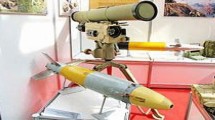Abstract
The Pirate and Terrorist Aversion System PITAS is a joint R&D project led by Raytheon Anschütz, Kiel. It aims at improving the safety on merchant and leisure vessels as well as on offshore facilities. PITAS connects to existing infrastructure and consists of a variety of modules. The system is flexible and can be installed permanently, or temporarily from a mobile container. Key elements are:
-
knowledge data base tapping various communication networks
-
data analysis providing threat scenarios and routing options
-
systems design integrating sensors and effectors, alarms and reactions
-
novel optical sensors and repellents
-
novel sonar sensor array for diver detection
-
novel close-range RADAR
-
track management based on radar and sonar data
-
situation-specific reactions, alarms and communications
-
automated pan and tilt platform for effectors
-
safety and security concepts
-
integrated and ergonomic human machine interface.
Access this chapter
Tax calculation will be finalised at checkout
Purchases are for personal use only
Preview
Unable to display preview. Download preview PDF.
Similar content being viewed by others
References
Bundespolizei See: Pirateriebericht der Bundespolizei See 4. Quartal 2011 / Jahresbericht 2011. Bundespolizei See, Sachbereich 12, Polizeiliche Auswertung und Analyse (PAA), Wieksbergstr. 54/0, 23730 Neustadt in Holstein (2012)
ICC 2012: International Chamber of Commerce, Piracy news and figures (2012), http://www.icc-ccs.org/piracy-reporting-centre/piracynewsafigures
Wallrabenstein, T.: Rechtliche Rahmenbedingungen für die Pirateriebekämpfung. Verband Deutscher Reeder. Kolloquium Seefahrt heute- zwischen Freiheit und Geiselhaft FH Flensburg (March 22, 2012)
Jopp, H.-D., Kaestner, R.: Eine globale Übersichtsanalyse von möglicher politisch oder ökonomisch motivierter maritimer Gewalt in den nächsten 20 Jahren. PiraT Arbeitspapier zur Maritimen Sicherheit Nr. 15, Hamburg (2012)
Engerer, H., Gössler, M.: Maritimer Terrorismus und Piraterie aus Sicht der deutschen Versicherungswirtschaft – Ergebnisse einer Befragung deutscher Transportversicherer. PiraT Arbeitspapier zur Maritimen Sicherheit Nr. 12, Hamburg (2011)
Engerer, H., Gössler, M.: Piraterie und maritimer Terrorismus aus Sicht deutscher Reeder – Ergebnisse einer Befragung. PiraT Arbeitspapier zur Maritimen Sicherheit Nr. 11, Hamburg (2011)
Van Hage, W.R., Malaisé, V., de Vries, G., Schreiber, G., van Someren, M.: Combining ship trajectories and semantics with the simple event model (SEM). In: Proceedings of the 1st ACM International Workshop on Events in Multimedia, pp. 73–80. ACM (2009)
Güting, R.H., Schneider, M.: Moving Object Databases. Morgan Kaufmann, San Francisco (2005)
Laube, P., van Kreveld, M., Imfeld, S.: Finding REMO - detecting relative motion patterns in geospatial lifelines. In: Fisher, P.F. (ed.) Proceedings of the 11th International Symposium on Spatial Data Handling Developments in Spatial Data Handling, pp. 201–214. Springer, Heidelberg (2004)
Böhm, M.: Integration von Informationen zu Piratenangriffen aus heterogenen Internetquellen mit einer Text-Mining-Komponente. Bachelor Thesis, Christian-Albrechts-University, Kiel (2011)
Skolnik, M.: Radar Handbook. McGraw Hill, Inc. (1990)
Daun, M., Ehlers, F.: Tracking Algorithms for Multistatic Sonar Systems. EURASIP Journal on Advances in Signal Processing 35, 1–28 (2010)
Konstantinova, P., Udvarev, A., Semerdjiev, T.: A Study of a Target Tracking Algorithm Using Global Nearest Neighbor Approach. In: Proceedings of the 4th International Conference on Computer Systems and Technologies: e-Learning, CompSysTech 2003, New York, USA, pp. 290–295 (2003)
Wilkens, K., Nguyen, V.D., Heute, U.: Adaptive Clutter Density in Multi-Hypothesis Tracking. In: Proc. IEEE ISIF GI Workshop Sensor Data Fusion, Berlin, Germany (2011)
Nguyen, V.D.: Small-Target Radar Detection and Tracking Within the PITAS Hard- and Software Environment. In: Aschenbruck, N., et al. (eds.) Future Security 2012. CCIS, vol. 318, pp. 335–346. Springer, Heidelberg (2012)
Harding, G., Harding, P., Wilkins, A.: Wind turbines, flicker, and photosensitive epilepsy: Characterizing the flashing that precipitate seizures and optimizing guidelines to prevent them. Epilepsia 49(6), 1095–1098 (2008)
DIN EN 61508-0: Funktionale Sicherheit sicherheitsbezogener elektrischer/elektronischer/programmierbarer elektronischer Systeme; Teil 0: Funktionale Sicherheit und die IEC 61508
Van Atta, L.C.: Electromagnetic Reflector, U.S Patent No. 2,908,002 (October 6, 1959)
Belfi, C., Rothenberg, C., Schwartzman, L., Tilley, R.E., Willis, A.: A satellite data transmission antenna. Transactions on IEEE Antennas and Propagation 2, 200–206 (1964)
Gupta, S.: Retro-directive noise correlation radar with extremely low acquisition time. In: IEEE Microwave Symposium, vol. 1, pp. 599–602 (2003)
Author information
Authors and Affiliations
Editor information
Editors and Affiliations
Rights and permissions
Copyright information
© 2012 Springer-Verlag Berlin Heidelberg
About this paper
Cite this paper
Culik, B., Lehmann, T., Zebermann, C. (2012). PITAS: Pirate and Terrorist Aversion System. In: Aschenbruck, N., Martini, P., Meier, M., Tölle, J. (eds) Future Security. Future Security 2012. Communications in Computer and Information Science, vol 318. Springer, Berlin, Heidelberg. https://doi.org/10.1007/978-3-642-33161-9_51
Download citation
DOI: https://doi.org/10.1007/978-3-642-33161-9_51
Publisher Name: Springer, Berlin, Heidelberg
Print ISBN: 978-3-642-33160-2
Online ISBN: 978-3-642-33161-9
eBook Packages: Computer ScienceComputer Science (R0)




